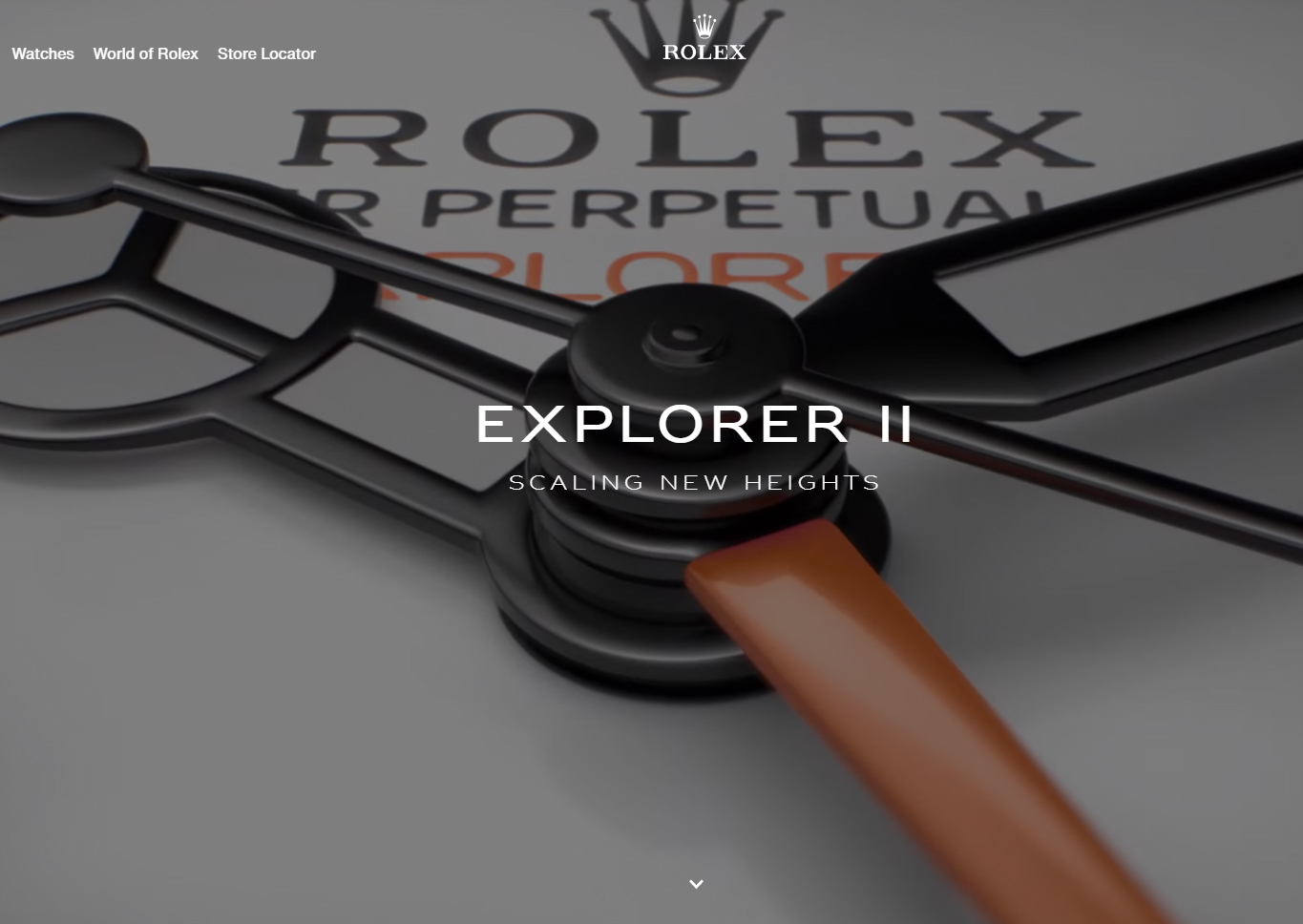
When it comes to Internet advertising, Rolex has an interesting advantage compared to most other contemporary luxury watch brands, writes Ariel Adams, founder and editor of aBlogtoWatch.
Rolex knows exactly how it wants people to purchase its products – which happens to be via one of many Rolex authorized dealers around the world – many of whom have recently been more active seeking out buyers online. Rolex’s focused distribution strategy is an advantage because it means that Rolex can implement a coherent and non-conflicted strategy when it comes to reaching online consumers. It should encourage its retailers to do more of this.
In comparison to Geneva-based Rolex, other luxury watch brands who actively compete with “the Crown,” such as Omega or Cartier, have a different approach. These brands – and others like them – blend a direct-to-consumer e-commerce experience with a traditional wholesale model. In practice, this means that such brands are trying to sell product directly to a consumer while simultaneously selling product to middle-people and third-party dealers who ostensibly are also trying to sell to the same or similar consumers.
This article is not a commentary on the wisdom of single or blended retail approaches, but rather how these strategies can be used online or how they can potentially inhibit healthy competition and digital efforts to gain consumer attention. Unlike so many of its competitors, Rolex knows that its goal is to get consumers to want their popular luxury timepieces, who then go seek out a nearby or known Rolex dealer in order to purchase the product. Rolex has no need to push traffic to its website any more so than it already has — because it does not sell watches — and when a consumer is interested in where to buy a Rolex, the brand points them in the direction of a local dealer.
Rolex is highly disciplined in this approach, as it signals a long-term strategy to rely on an army of authorized dealers, none of which Rolex has a financial stake in, and all of whom invest in each production run of new products. Rolex supports (and some might argue “rules”) its retailers, but it also seeks to empower them. A retailer who can sell watches is a good, long-term customer. Rolex has every incentive to increase the selling power of its each and every door (industry-speak for a retail store). It helps dealers with beautiful storefronts and gives them excellent tools to help sell. But why hasn’t it empowered its army of authorized dealers to do much in the area of campaigning for business online?
More than two years ago now, Rolex corporate made the decision to cease advertising in “watch media,” including both print and digital publications. While Rolex has not officially commented on this policy, the logical inference from this rather harsh decision (for watch media, that is) is that Rolex wants to encourage its authorized dealers to take up the mantle and advertise online in their stead — but that hasn’t happened yet.
Billboards
Drive through the streets of most major cities, and you’ll see co-brands’ billboard ads for Rolex watches with the name of a local dealer where consumers can go check out the latest (in-stock) timepieces. Those are called “co-op ads” because their cost is often shared between Rolex and the retailer as part of a mutual investment. Rolex is, no doubt, planning to encourage its retailers to do the same thing on the Internet, but to do so it must abandon its traditional notion of watch retailer territory.
The still-unspoken challenge of Internet advertising is how to “protect” (or at least “preserve”) the foundational regional territoriality of how authorized dealers do business. The traditional notion is that a watch retailer authorized by Rolex to sell watches would have a limited territory within which to have some protected status as the sole retailer of those products. This isn’t the case in all cities, but for the most part a Rolex dealer has some assurance of how much competition they will have to face in their home market. This, in turn, allows them to make more predictable and secure investments in product — much of which must be paid for in advance prior to actually getting it.
When it comes to advertising on the Internet, regional lines and traditional territories immediately lose importance. Rolex and its retailers are probably right now grappling with the logistics of how co-op online advertising spending will even work. What rules will retailers need to follow? What restrictions might they have? Will they be allowed to sell watches outside of their city? Outside of their country? What happens when two retailers want to advertise in the same space and Rolex is called in to act as an intermediary? How can Rolex politically and practically manage an entirely new set of concerns?
Yet these concerns are crucial and must be dealt with by Rolex sooner than later if they wish to maintain their top position. Advertising presence is the life blood of the luxury watch industry and, at this time, Rolex relies on fans and fervor to do it selling there. It means Rolex does not have on the Internet what it so enjoys in the face-to-face world: control.
Cracking the code
All evidence seems to suggest that without prolific and constant marketing and advertising, the demand for luxury watches drops like a gold watch in a pond. Nevertheless, no big brand has — to its own satisfaction — cracked the code of how to find comfort in online advertising to garner the type of consumer attention necessary, which by itself leads to the pursuit of their products. In other words, outside of gimmicks and luck, most luxury watch brands are outmaneuvered on the Internet by smaller and newer companies with far less impressive products.

Since so much of the consumer space is already online and moving more in that direction, it is of paramount importance that watch brands get real about what investing in Internet advertising actually looks like. Rolex has an opportunity to be a leader. It can leverage its voluminous Rolodex of retailers to each advertise online independently, creating a large net of marketing noise and awareness online. All Rolex needs to do is formally allow it, make co-op advertising dollars available for such spending… and its ambitious retailers will do the rest.
That latter point is truly important, because it takes the burden off Rolex to manage and plan the incredible nuances necessary to make online advertising decisions. It needs to trust that because its retailers are spending their own dollars, too; they will be actively monitoring the performance of their respective digital marketing spends. A legion of smaller decision-makers will ultimately make more correct marketing demographic decisions than a company trying to make centralized decisions. Indeed, what I am suggesting is that watch brands will be overburdened by trying to make too many online marketing decisions on their own. A better strategy is to allow their retailers to do such. Rolex is probably the best situated company to do so. More so, if their current strategy is to be understood, it is the direction that Rolex is moving in.
The entire watch industry stands to gain. In 2019, I wrote a detailed discussion of how systematic defunding of advertising in the luxury industry meant that Rolex alone was spending enough money to create mainstream consumer demand for Swiss Made luxury watches. Without Rolex’s considerable spending on events, name placements, sponsorships, and more real-world marketing assets, the luxury watch industry could easily withdraw in to relative obscurity among mainstream consumers.
Rolex probably doesn’t want to be saddled with the same investment burden when it comes to the considerable cost of Internet advertising. It can avoid much of this headache by simply empowering its retailers with permission and payments to invest in online advertising, as they please. Rolex will supply its typical pre-authorized advertising graphics and assets, but retailers should have broad freedom to place them where they like.
This implies that traditional regional restrictions on advertising ought to be eradicated when it comes to the Internet. It simply doesn’t make practical sense to impose restrictions that do not go along with how Internet advertising mainly works. Rolex should encourage some healthy competition among its retailers by, in effect, allowing them to compete with each another. What I believe will happen is not rigid standoffs, but rather a deep exploration of niche communities online, as well as an ever-expanding interest in finding new places to seek customers. Fully online advertising, in an effective manner, is to place your marketing message in every nook and cranny, as opposed to the widely visible traditional advertising places — more so with the available sophistication that micro-targeting online to special enthusiast communities or interest groups will allow retailers to find audiences they speak to most comfortably.
It is common wisdom that watch consumers respond most to advertising they feel has them in mind. Centralized watch brands advertising products at headquarters typically has no one audience in mind. By nature, centralized ad campaigns are generic and thus not personal in nature. Rolex is not prepared (or wise) to take on the responsibility of trying to craft individual messages to all possible watch consumer audiences out there. Rolex is wise to encourage its authorized dealers to specialize in a particular consumer demographic and advertise to them in any way they see fit.
I return to my original question of, “When will Rolex mobilize its army of authorized dealers to campaign for business online?” For me, the question is not a matter of “if” but rather a matter of “when,” as I have stated, given the current trends — and via an analysis of what Rolex has seemingly been planning. I do worry that Rolex is taking their time, however. The company that “wants to do everything right” cannot be faulted for dragging its feet when it comes to opening up the rules and budget to allow its retailers to go online in pursuit of new customer relationships. They will not, however, find a better time than now.
Digital media is comparatively cheap given the COVID-19 pandemic fallout, and Rolex retailers would have enormous Internet market visibility available for purchase. Rolex could actually canvas much of the online places watch consumers frequent with its retailers’ messaging and actually prevent its competitors from doing the same, once they wise up. In just six months from now, the available share of Internet marketing voices on media platforms will be markedly less than now, and also more expensive as a result of many other competitive advertisers being active again. Rolex has a powerful (albeit limited) window to encourage its retailers to relatively cheaply and effectively campaign online. I hope it chooses to do so.
About the author: Ariel Adams is founder and editor of aBlogtoWatch.


The Rolex dealer I have been buying from for 20 years is so important that he doesn’t even take my calls anymore and apparently has no stock to sell to me. I suspect he is selling to croneys to get a premium,. I think its doing the brand damage. Still like the watches, just wish I could buy one!